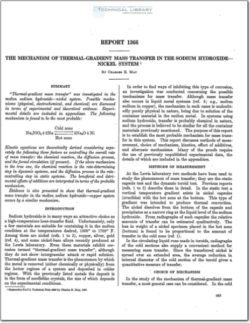NACA-Report-1366

- Version
- 167 Downloads
- 1.98 MB File Size
- 1 File Count
- December 4, 2015 Create Date
- December 4, 2015 Last Updated
National Advisory Committee for Aeronautics, Report - The Mechanism of Thermal Gradient Mass Transfer in the Sodium Hydroxide Nickel System

Sodium hydroxide is in many ways an attractive choice as
a high-temperature heat—transfer fluid. Unfortunately, only
a few materials are suitable for containing it in the molten
condition at the temperatures desired, 1500° to 1700° F.
Among these are nickel (refs. 1 to 3), copper, silver, gold
(ref. 4), and some nickel-base alloys recently produced at
the Lewis laboratory. Even these materials exhibit cor—
rosion termed “thermal-gradient mass transfer”, although
they do not show-intergranular attack or rapid solution.
Thermal—gradient mass transfer is the phenomenon by which
the metal is removed (either chemically or physically) from
the hotter regions of a system and deposited in colder
regions. With the previously listed metals the deposit is
in the form of needlelike crystals, the size of which depends
on the experimental conditions.
In order to find ways of inhibiting this type of corrosion,
an investigation was conducted concerning the possible
mechanisms for mass transfer. Although mass transfer
also occurs in liquid metal systems (ref. 5; e.g., molten
sodium in copper), the mechanism in such cases is undoubt-
edly purely physical in nature, being due to solution of the
container material in the molten metal. In systems using
sodium hydroxide, transfer is probably chemical in nature,
and the process is believed to be similar for all the container
materials previously mentioned. The purpose of this report
is to establish the most probable mechanism for mass trans-
fer in this system. This report discusses methods of meas-
urement, choice of mechanism, kinetics, effect of additives,
and alternate mechanisms. Many of the proofs require
the use of previously unpublished experimental data, the
details of which are included in the appendixes.
At the Lewis laboratory two methods have been used to
study the phenomenon of mass transfer; they are the static
capsule test and the dynamic toroid test. Previous reports
(refs. 1 to 3) describe these in detail. In the static test a
vertical temperature gradient exists in nickel capsules
(crucibles) with the hot zone at the bottom. This type of
gradient was intended to produce thermal convection.
The nickel dissolves from the bottom of the capsule and
precipitates as a narrow ring at the liquid level of the sodium
hydroxide. From radiographs of such capsules the relative
amounts of transfer can be estimated qualitatively. The
loss in weight of a nickel specimen placed in the hot zone
(bottom) is found to be proportional to the amount of
transfer in the cold zone (ref. 1).
| File | Action |
|---|---|
| naca-report-1366.pdf | Download |

Comment On This Post